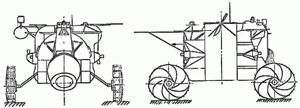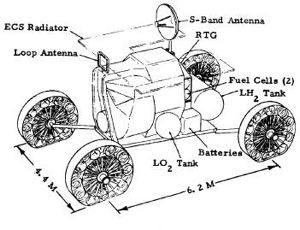MOLEM (original) (raw)

Home - Search - Browse - Alphabetic Index: 0- 1- 2- 3- 4- 5- 6- 7- 8- 9
A- B- C- D- E- F- G- H- I- J- K- L- M- N- O- P- Q- R- S- T- U- V- W- X- Y- Z
MOLEM
American manned lunar rover. Study 1966. Third generation versions of LM derivative equipment were studied by Grumman in a report delivered on 10 May 1966.
AKA: Mobile LM Shelter. Status: Study 1966.
The LM shelter was further modified to become a mobile shelter (MOLEM); thereby eliminating the need for a separate lunar roving vehicle (LRV).
Two versions were studied; a "minimum" change (four wheel vehicle) and "moderate" change (four wheel vehicle plus two wheel trailer). The MOLEM was designed to support two men for 14 days and traverse 460 km in a 90 km radius. The flight mode was an LOR using a manned CSM to control lunar landing. The MOLEM could be used on either a modified LM descent stage or an LM Truck. Pertinent additions were Allis Chalmers fuel cells (total 8 kw), a deployable (collapsible) airlock, and a three-month quiescent storage capability. Two 50 watt RTG's were required for quiescent storage. The study assumed high-pressure ambient temperature oxygen/hydrogen storage, but also evaluated a cryogenic system, which resulted in weight savings in the order of 340 to 450 kg and provided additional volume for experimentation at some cost in development time and (possibly) reliability.
The MOLEM would have a cabin atmosphere of pure oxygen at 0.34 atmosphere pressure. The minimum change vehicle would have a mass of 4112 kg and a maximum speed over soft soil of 10 kph and 26 kph over compacted soil. The moderate change vehicle would have a mass of 4143 kg and top speeds 50% higher.
In 1966 the MOLEM was evaluated by Bendix against other concepts in the MOBEV study under contract NAS8-20334. Here the MOLEM configuration was modified to a common standard for comparative purposes. cabin was a modified LM ascent stage and was mounted on an aluminum box beam frame supported by two pairs of metal-elastic wheels. The wheels were folded for unmanned delivery on the LM Truck. The ECS radiators, S-band communications antenna, and a direction-finding loop antenna were located on top of the cabin. Scientific equipment lockers were located at the rear platform. The RTG, batteries, liquid hydrogen tank, fuel cells, primary power accessories, and the mobility control unit were located on the aft platform. Liquid O2 tanks were located on each side of the cabin. The limited cabin volume of the MOLEM necessitated cramped living conditions, stand-up driving, and a minimal size airlock with questionable emergency operation capability. None of the three mobility derivative vehicles (MOLEM, MOCOM, and MOCAN) were retained as MOBEV Design Point Vehicles. They did not offer the planner any measurable advantages in terms of performance, mass, or cost over a system which was designed specifically for mobility use, such as MOLAB.
MOLEM Summary
- Delivered Mass (kg): 3322
- Cabin Free Volume (ft3): 150
- Total Mission Energy (kwh): 693
- Mobility Specific Energy (kwh/km): .44
- Maximum Average Speed-ELMS (km/hr): 10.0
- Obstacle Negotiability: (cm) 80
- Crevice Negotiability: (cm} 173
- Development Cost: ($million) 273.3
- Development Time (years): 4.75
- Storage Envelope and Mass: LM Truck, 3860 kg
- Crew Size: Two, 95th Percentile
- Scientific Mission Duration: 14 Days (+7 Day Life Support Contingency)
- Lunar Standby Period: Six Months
- Operating Period: One lunar Day and/or Night
- Scientific Payload & Energy: 320 kg and 73 kWh
- Mobility Range & Radius: 400 km and 80 km
- Surface Model: ELMS: 50/50 Maria and Highland
- Ingress/Egress Cycles: 40
- Vehicle Operation: Manned and Remote Control
Comparison of significant characteristics for MOLEM, MOCOM, and MOCAN showed that each of the designs provided for a crew of two and a scientific payload of 320 kg for a 14-day mission with a 400-km range. The only vehicle exceeding the LM Truck payload capability of 3860 kg for a full-up mission was the MOCAN. Since the delivery mass constraint had been exceeded, MOCAN performance had to be degraded to a 200-km, 8-day mission in order to meet the assumed LM Truck payload. The cabin free volumes, with the exception of MOLEM, were within the NASA stipulated desired volume of 175 cu ft for a two-man, 14-day mission. Fuel cell systems were used for primary power and were sized to supply the total energy requirements of 693, 695, and 734 kwh, respectively, for the MOLEM, MOCOM, and MOCAN. Mobility specific energy for MOLEM, MOCOM, and MOCAN were, respectively, 0.44, 0.49, and 0.59 kwh/km. The maximum average speed was 10 km/hr, over a 50/50 ELMS and 16.7 km/hr on a hard surface for all three vehicles. Obstacle and crevice negotiability was based on vehicle geometry. For MOLEM, MOCOM, and MOCAN, respectively, the obstacle negotiability was 80, 70, and 60 cm; and the crevice negotiability was 173, 157, and 146 cm. Development costs of 273.3millionforMOLEM,273.3 million for MOLEM, 273.3millionforMOLEM,282.3 million for MOCOM, and $291.7 million for MOCAN do not include the cost of 13 basic development shells or the flight shell. Development time for all three mobility derivatives was 4.75 years.
Family: Lunar Rovers, Moon. Country: USA. Agency: NASA, Grumman. Bibliography: 1993.
Photo Gallery
 |
MOLEM |
|---|
Home - Search - Browse - Alphabetic Index: 0- 1- 2- 3- 4- 5- 6- 7- 8- 9
A- B- C- D- E- F- G- H- I- J- K- L- M- N- O- P- Q- R- S- T- U- V- W- X- Y- Z
© 1997-2019 Mark Wade - Contact
© / Conditions for Use
